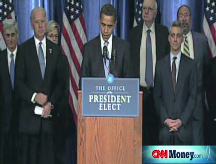Jobless claims at 26-year high
Number of people filing for initial unemployment insurance surges to 573,000 in latest week.
NEW YORK (CNNMoney.com) -- The number of Americans filing new unemployment insurance claims jumped last week to a 26-year high, surpassing the number of filings economists had predicted.
The Labor Department reported Thursday that initial filings for state jobless benefits surged to 573,000 for the week ended Dec. 6. That was an increase of 58,000 from a revised 515,000 claims in the previous week.
It was the highest number of jobless claims since Nov. 27, 1982 when initial filings hit 612,000. Economists were expecting jobless claims increase to 525,000, according to a consensus compiled by Briefing.com.
The four-week moving average of jobless claims, which works to eliminate fluctuations in data was 540,500 last week, an increase of 14,250 from the previous week's revised average of 526,250.
One economist said the number of initial claims decreased in the previous report because the data from that report represented the week of Thanksgiving. Some of the surge in initial filings in this current report could be a bounce from that week.
However, "the underlying trend in the labor market is that it continues to weaken," said Jay Bryson, global economist with Wachovia Economics, and that is evident in the 4-week moving averages of initial claims.
The number of people continuing to collect unemployment rose to 4,429,000 in the week ended Nov. 29, the most recent week available, which was also a 26-year high. The measure was an increase of 338,000 from the preceding week's revised level of 4,091,000.
The last time continuing claims was at such an elevated level was Dec. 4, 1982, when continuing claims hit 4,509,000.
Meanwhile, the 4-week moving average of continuing claims was 4,133,500, an increase of 130,750 from the previous week's revised average of 4,002,750.
With the U.S. economy officially in a recession, unemployment has been on the rise. The economy shed 533,000 jobs in November and the unemployment rate rose to 6.7% from 6.5% in October, according to a government report released last week.
So far this year, the economy has lost 1.9 million jobs.
The economy has fallen into a recession, and the nation's gross domestic product - the largest measure of the economy's health - contracted by 0.5% in the three months ended Sept. 30. Bryson said that he expects the GDP to contract even further in the coming quarter.
When companies see their orders decrease, they simply don't keep as many workers on the payroll.
As workers lose their jobs, that hits states particularly hard.
"Not only, when people get laid off do income taxes go down, but they start drawing unemployment compensation," said Bryson. "So whenever you are in a recession, you see the deficit widen."
According to a report from Center on Budget and Policy Priorities, 43 states are facing shortfalls in their budgets for this year, and as people continue to lose their jobs, states are pinched further.
The largest increases in initial jobless claims for week ended Nov. 29 - the week before last - were in Wisconsin, Iowa, Arkansas, Mississippi, and North Dakota. The largest decreases in initial filings were in California, Florida, Missouri, Michigan, and Texas. ![]()





